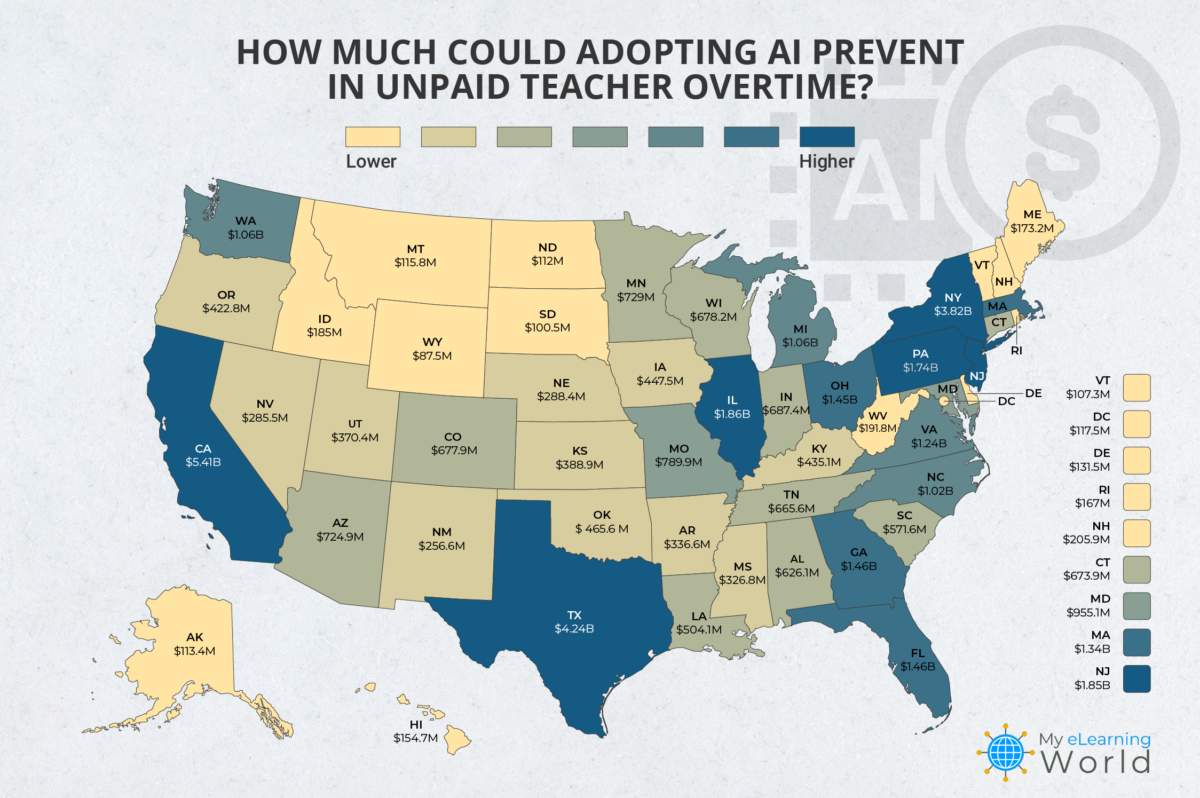Teachers in the U.S. are no strangers to long hours and extensive unpaid overtime. As we detailed in our recent report, the average teacher logs about 54 hours per week during the school year, adding up to an extra 540 hours annually beyond their contracted hours. This represents a staggering 1.74 billion hours of unpaid overtime across the country and a whopping $77.5 billion in unpaid overtime work.
But this got us wondering – with AI revolutionizing the way people work in a variety of industries, could this tech also keep teachers from having to put in excessive overtime hours?
The reality is teachers only spend 46% of their time teaching. The rest of the hours they’re working are largely spent on tasks like lesson planning, grading papers, emailing parents, and general admin work — all things that AI could potentially streamline or automate.
After carefully analyzing exactly how much time teachers spend on various tasks, we found that implementing AI technologies could potentially regain teachers about 7.7 hours per week, totaling 300.3 hours per school year. In other words, AI could eliminate 56% of their unpaid overtime hours.
When you look at it on a nationwide scale, that means AI could save teachers across the country 965,366,302 hours of unpaid overtime work each year. That represents $43,379,863,501 in unpaid overtime work.
Our Methodology
To accurately estimate how much time AI technology could save teachers each week, we employed a detailed task-by-task analysis approach. Here’s how we structured our methodology:
- Task Identification: We began by identifying key tasks that consume significant portions of a teacher’s workweek, such as grading, lesson planning, administrative duties, student interaction, collaboration with colleagues, and communication with parents. Using data from EdWeek, we were able to see exactly how many hours per week the average teacher spends on these specific tasks.
- Assessment of AI Applicability: For each task, we evaluated the potential applicability of AI technologies, considering current advancements in AI capabilities. This included automated grading systems, AI-driven resource gathering, administrative bots, AI chat support for students, and communication automation tools.
- Impact Estimation: We then estimated the percentage of each task that could realistically be automated or assisted by AI, based on existing use cases and pilot programs within educational settings.
- Time Calculation: We calculated the actual time savings by applying the AI impact percentage to the average time teachers currently spend on each task. This calculation provided a quantitative measure of hours potentially saved per task per week.
- Aggregation of Savings: Finally, we aggregated the estimated time saved from all tasks to determine the total potential weekly time savings for teachers. We cross-referenced this with the data from our recent report on unpaid teacher overtime.
Here’s the breakdown of potential weekly time savings across various tasks:
- Grading & Providing Feedback on Student Work: Currently, the average teacher spends 5 hours a week grading & providing feedback on student work. AI could save approximately 3 hours by automating 60% of the task.
- Planning or Preparing for Lessons: The average teacher spends 5 hours a week planning or preparing for lessons. AI’s ability to assist in resource gathering and lesson outlining could save about 1.5 hours, automating 30% of this workload.
- General Admin Work: Teachers clock 3 hours on general admin work each week. With AI streamlining 50% of administrative tasks, teachers could see a reduction of 1.5 hours weekly.
- Non-Teaching Student Interaction: The typical teacher spends 3 hours on non-teaching student interaction every week. Implementing AI chatbots could reduce the time spent by 0.9 hours, handling 30% of student interactions.
- Collaborating/Planning with Colleagues: Teachers put in 2 hours collaborating/planning with colleagues weekly. AI’s limited role could still cut down time spent by 0.2 hours by preparing meeting materials (10% of the task).
- Communicating with Parents: Teachers spend 2 hours communicating with parents (e.g. sending emails, app update messages, etc.) every week. Automating updates and reports could decrease time spent by 0.6 hours, covering 30% of the communication tasks.
In total, our methodology suggests that AI integration could save teachers up to 7.7 hours per week, allowing them more time to focus on enhancing educational outcomes and engaging more directly with students.
Final Thoughts
Integrating AI into the classroom could drastically ease the workload for teachers, potentially cutting 56% of unpaid overtime.
We’re talking about saving nearly a billion hours of teacher overtime each year, which equals over $43 billion in unpaid work.
By taking over routine tasks like grading and scheduling, AI gives teachers more time to do what they do best — teach.
- Elevating Your Virtual Presence: Why EMEET’s SmartCam S800 Stands Out in Modern Communication - 06/04/2025
- US Teachers Will Spend $3.35 Billion of Their Own Money on Classroom Expenses in 2025-25 School Year - 06/04/2025
- Report: Leveraging AI Tools Could Help US Teachers Avoid $43.4 Billion of Unpaid Overtime Work - 06/04/2025


